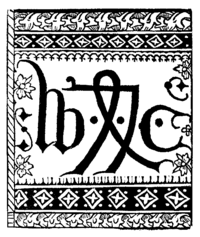Dictes and Sayings of the Philosophers
Dictes and Sayings of the Philosophers ("The Sayings of the Philosophers") is an incunabulum, or early printed book. The Middle English work is a translation, by Anthony Woodville, of an original book written in Arabic by the medieval Arab scholar al-Mubashshir ibn Fatik', titled Mukhtār al-ḥikam wa-maḥāsin al-kalim (مختار الحكم ومحاسن الكلم)[1] which had been translated into several languages. Woodville based his version on an earlier French translation. His translation would come to be printed by William Caxton in 1477 as either the first, or one of the earliest, books printed in the English language.[2]
Description
The manuscript of the French translation Dits Moraulx des Philosophes describes itself as a compendium of the words of wisdom, or collected quotations, from biblical, classical, and legendary philosophers, written in prose form. Generally the chapters are introduced by some biographical notes on the philosopher, followed by passages of his attributed quotations, which vary in length from a few words to several pages.

History of original and earlier translations
The Arabic original is known as Mukhtār al-ḥikam wa-maḥāsin al-kalim ('Compendium of Maxims and Aphorisms'), and was written toward the middle of the eleventh century by a Syrian-born emir of the Fatimid Caliphate of Egypt, Al-Mubashshir ibn Fatik.[2] The earliest European translation was the Spanish Los Bocados de Oromade, made in the reign of Alfonso X of Castile (1252–1284). Wisdom literature became popular throughout medieval Europe and subsequently versions appeared in several languages, including Latin, Occitan, Old Spanish, and Old French. In 1450 Stephen Scrope produced a Middle English translation, titled Dicts and Sayings of the Philosophers.[3] At least three additional Middle English versions are extant; the Helmingham Hall MS (anonymous), William of Worcester's (reliant on Scrope's), and Anthony Woodville, Earl Rivers's translation (printed by William Caxton).[4]
Caxton's published translation
Anthony Woodville, 2nd Earl Rivers's English translation of The Dictes and Sayings of the Philosophers was printed at least three times by William Caxton and once by Wynkyn de Worde. Two famous manuscript copies include MS Additional 22718 (British Library) and MS 265 (Lambeth Palace Library).[5] Woodville made his translation during his voyage to the shrine of Santiago de Compostela in Spain. In 1473 the knight Lewis de Bretaylle had lent him a French manuscript called Les ditz moraulx des philosophes, by Guillaume de Tignonville. This turn-of-the-fifteenth-century French translation was based on a Latin version.
Caxton reviewed Woodville's completed translation and added an epilogue. In this Caxton points to Woodville's omission of Socrates' remarks on women, which subsequently led to the inclusion of an additional chapter, titled "Touching Women".[2] The first printing of the book is dated as 18 November 1477.[6]
In 1476 Caxton had travelled to Westminster from Bruges, where he had been running a successful printing business. He wanted to practise his new printing skills in his native country. He had perhaps learned printing technology in Cologne. The first book Caxton printed with a date was Dictes and Sayings of the Philosophers, although it is not usually regarded as the first book he had printed in England.[2]
Notability
This is the first dated book printed in England. It contains not only the date, but for the first time in England a printer's colophon showing the name of the printer, and the place of publication.[2]
See also
Notes
- [waqfeya.com/book.php?bid=6216 Al-Mukhtar al-Hakim wa Muhasin al-Kalim]
- DNB, p. 383
- The Mirroure of the Worlde: A Middle English Translation of Le Miroir Du Monde
- Joseph Power’s Note Attached to Earl Rivers’s English Translation of The Dictes and Sayings of the Philosophers by Yoko Iyeiri & Mitsumi Uchida (2017).
- Joseph Power’s Note Attached to Earl Rivers’s English Translation of The Dictes and Sayings of the Philosophers by Yoko Iyeiri & Mitsumi Uchida (2017); p.19
- Blake, N. F. William Caxton and English Literary Culture. p. 99.
Bibliography
- Blake, Norman Francis (1991). William Caxton and English Literary Culture. A&C Black. ISBN 1852850515.
- The Cambridge History of English and American Literature, Volume II.
- . Dictionary of National Biography. London: Smith, Elder & Co. 1885–1900.
External links
- The dictes and sayings of the philosophers: a facsimile reproduction of the first book printed in England by William Caxton, in 1477. London: E. Stock. 1877.
- "DH300 Dictes Edition Project". An ongoing collated edition of all four printed editions of the Dictes and Sayings of the Philosophers created in a practicum module at Wilfrid Laurier University, started in February 2017.